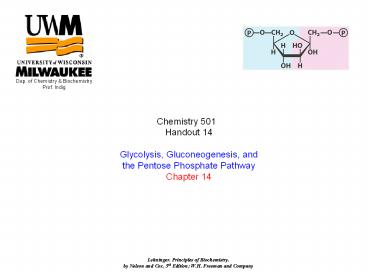Chemistry 501 Handout 14 Glycolysis, Gluconeogenesis, and - PowerPoint PPT Presentation
1 / 50
Title:
Chemistry 501 Handout 14 Glycolysis, Gluconeogenesis, and
Description:
Dep. of Chemistry & Biochemistry Prof. Indig Chemistry 501 Handout 14 Glycolysis, Gluconeogenesis, and the Pentose Phosphate Pathway Chapter 14 Lehninger. – PowerPoint PPT presentation
Number of Views:144
Avg rating:3.0/5.0
Title: Chemistry 501 Handout 14 Glycolysis, Gluconeogenesis, and
1
Chemistry 501 Handout 14 Glycolysis,
Gluconeogenesis, and the Pentose Phosphate
PathwayChapter 14
Lehninger. Principles of Biochemistry. by Nelson
and Cox, 5th Edition W.H. Freeman and Company
2
Major pathways of glucose utilization
3
The first phase of glycolysis (the preparatory
phase)
4
The second phase of glycolysis (the payoff phase)
O
5
The two phases of glycolysis
6
Three possible catabolic fates of the pyruvate
formed in glycolysis
7
1. Phosphorylation of glucose
8
2. Conversion of glucose 6-phosphate to fructose
6-phosphate
9
The phosphohexose isomerase reaction
anomeric carbon
10
3. Phosphorylation of fructose 6-phosphate to
fructose 1,6-bisphosphate
11
4. Cleavage of fructose 1,6-bisphosphate
12
The class I aldolase reaction
imine
13
5. Interconversion of the triose phosphates
Fate of the glucose carbons in the formation of
glyceraldehyde 3-phosphate
14
6. Oxidation of glyceraldehyde 3-phosphate to
1,3-bisphosphoglycerate
15
The glyceraldehyde 3-phosphate dehydrogenase
reaction
16
7. Phosphoryl transfer from 1,3-bisphosphoglycera
te to ADP
17
8. Conversion of 3-phosphoglycerate to
2-phosphoglycerate
18
The phosphoglycerate mutase reaction
19
9. Dehydration of 2-phosphoglycerate to
phosphoenolpyruvate
20
10. Transfer of the phosphoryl group from
phosphoenolpyruvate to ADP
21
Entry of glycogen, starch, disaccharides, and
hexoses into the preparatory stage of glycolysis
Feeder pathways for glycolysis
22
Feeder pathways for glycolysis
23
Dietary polysaccharides and disaccharides undergo
hydrolysis to monosaccharides
24
Glycogen breakdown by glycogen phosphorylase
25
Other monosaccharides enter the glycolytic
pathway at several points
26
Conversion of galactose to glucose 1-phosphate
Defects in any of the three enzymes in this
phatway Cause galactosemia in humans
Galactose methabolite involved in
galactokinase-deficiency galactosemia
27
Fates of pyruvate under anaerobic conditions
Fermentation
Pyruvate is the terminal electron acceptor in
lactic acid fermentation
no net change in NAD or NADH
acidification in muscle and blood limits
the period of vigorous activity
28
Ethanol is the reduced product in ethanol
fermentation
tightly bound coenzyme, thiamine pyrophosphate
Industrial-scale fermentations yield a variety of
common foods and industrial chemicals
29
The alcohol dehydrogenase reaction
30
Thiamine pyrophosphate (TPP) and its role in
pyruvate decarboxylation
31
Thiamine pyrophosphate
32
Gluconeogenesis
Carbohydrate synthesis from simple precursors
33
Opposing pathways of glycolysis and
gluconeogenesis in rat liver
34
(No Transcript)
35
Synthesis of phosphoenolpyruvate from pyruvate
36
Role of biotin in the pyruvate carboxylase
reaction
37
Alternative paths from pyruvate to
phosphoenolpyruvate
38
Citric acid intermediates and many amino acids
are glucogenic
Citrate Isocitrate a-ketoglutarate Succinyl-CoA Su
ccinate Fumarate Malate
Pyruvate
oxaloacetate
C.A.C.
Amino acid catabolism
C.A.C. Intermediates
39
(No Transcript)
40
(No Transcript)
41
(No Transcript)
42
(No Transcript)
43
Feeder pathways for glycolysis (preparatory phase)
44
General scheme of the pentose phosphate pathway
of glucose oxidation
45
Oxidative reactions of the pentose phosphate
pathway
NADP
46
Nonoxidative reactions of the pentose phosphate
pathway
The nonoxidative phase recycles pentose
phosphates to glucose 6-phosphate
47
The first reaction catalyzed by transketolase
thiamine pyrophosphate
General reaction Transfer of a two-carbon group
from a ketose donor to an aldose acceptor
48
The reaction catalyzed by transaldolase
The second reaction catalyzed by transketolase
49
Role of NADPH in regulating the partitioning of
glucose 6-phosphate between glycolysis and the
pentose phosphate pathway
50
Role of NADPH and glutathione (GSH) in protecting
cells against highly reactive oxygen derivatives































